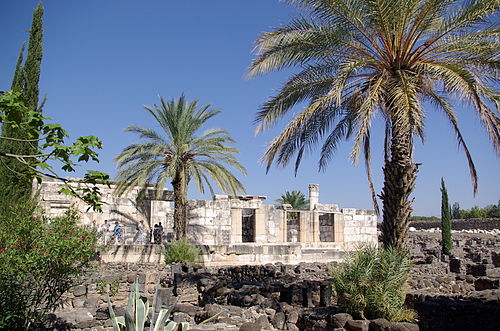This articleneeds additional citations forverification. Please helpimprove this article byadding citations to reliable sources. Unsourced material may be challenged and removed. Find sources: "Palaestina Secunda" – news ·newspapers ·books ·scholar ·JSTOR(August 2024) (Learn how and when to remove this message) |
| Provincia Palaestina Secunda ἐπαρχία Δευτέρα Παλαιστίνης | |||||||||
|---|---|---|---|---|---|---|---|---|---|
| Province of theDiocese of the East,Byzantine Empire | |||||||||
| 390–636 | |||||||||
 Byzantine Palestine in the 5th century | |||||||||
| Capital | Scythopolis | ||||||||
| Historical era | Late Antiquity | ||||||||
• division of the Roman Empire | 390 | ||||||||
• Jewish revolt and Persian occupation | 614–625 | ||||||||
| 636 | |||||||||
| |||||||||
| Today part of | Israel Jordan Palestine Syria | ||||||||
Palaestina Secunda orPalaestina II was aprovince of theByzantine Empire from 390,[1] until its conquest by the Muslim armies in 634–636. Palaestina Secunda, a part of theDiocese of the East, roughly comprised inlandGalilee, theJezreel (Yizrael) Valley,Bet Shean Valley, and the corresponding area ofTransjordan (parts of the formerDecapolis, with the southern territories of theGolan plateau and the bishopric ofPella south of theYarmuk River), with its capital inScythopolis (Bet Shean). The province experienced the rise of Christianity under the Byzantines, but was also a thriving center of Judaism, after the Jews had been driven out of Judea by the Romans as a result of their 1st- and 2nd-century revolts.

Syria-Palaestina became organized under late Roman Empire as part of theDiocese of the East, in which it was included together with the provinces ofIsauria,Cilicia,Cyprus (until 536),Euphratensis,Mesopotamia,Osroene,Coele-Syria,Syria Phoenice andArabia Petraea. Under Byzantium, a new subdivision did further split the province of Cilicia into Cilicia Prima, Cilicia Secunda; Syria Palaestina was split intoPalaestina Prima, Palaestina Secunda and eventually also Palaestina Salutaris (in 6th century). The major cities of the province wereScythopolis,Capernaum andNazareth.

In the 5th and 6th centuries, Byzantines and their ChristianGhassanid allies took a major role in suppressing theSamaritan Revolts in neighbouring Palaestina Prima.By the 6th century Christian Ghassanids formed a Byzantine vassal confederacy with a capital on the Golan, forming a buffer state between the Byzantine Empire and the Arabian tribes.
In 614, both Palaestina Prima and Palaestina Secunda wereconquered by a joint Sasanian-Jewish army. The leader of the Jewish rebels wasBenjamin of Tiberias, a man of "immense wealth" according to Middle Age sources, and byNehemiah ben Hushiel, a Jewish Exilarch. The event came as shock to the Christian society, as many of its churches were destroyed according to Christian sources of that period. After withdrawal of the Persian troops and the afterward surrender of the local Jewish rebels, the area was shortly reannexed into Byzantium in 628 CE.[2]
Byzantine control of the province was again and irreversibly lost in 636, with theMuslim conquest of Syria. It was later roughly reorganized asJund al-Urdunn military district ofBilad al-Sham (Syria) province of theRashidun Caliphate.
Prior to the 6th century, the province of Palaestina Secunda largely included Jews, as well as a mixed Greek and Aramaic-speaking population, who were mostly practicing Christianity. The Jews had made Galilee and theGaulanitis their center since the defeat of theBar Kokhba revolt of the 2nd century;[1] and flourished through the 4th and 5th centuries, as Byzantine control of the area dimmed, providing a great deal of autonomy for local populations.
North-Eastern parts of the province were also inhabited by paganItureans, who lived in more significant numbers in the neighbouring Phoenicia and Phoenicia Libani provinces to the north. Christian ArabGhassanids migrated to the province from Yemen in around 4th and 5th centuries and settled the Gaulanitis, as well as former territories of Arabia Petraea province, creating a buffer Byzantine client kingdom in the 6th century, with the capital on the Gaulanitis - the North-Eastern border of Palaestina Secunda.
In the early 7th century, the province experienced a significant demographic collapse due to the consequences of the Byzantine-Persian war and the Jewish rebellion. Following the short-lived restoration of Byzantine rule, the Muslim armies caused the flight of a significant portion of the Christians to the north - into territories of northern Syria and Anatolia still ruled by the Byzantines.
The province of Palaestina Secunda was a thriving center of Judaism through the 4th and 5th centuries, where theJerusalem Talmud was compiled. The primary Jewish authority, theSanhedrin, existed in Tiberias until the early 5th century, before being abolished by the Byzantine authorities. The lastNasi (president) of theSanhedrin wasGamaliel VI, who died in 425. After his death, the Byzantine EmperorTheodosius II did not allow for a successor, and in 429 terminated the patriarchate.
The conversion of Constantine set in motion events that restored Palestine as a major theater in the development of the Christian church, as it had not been since 70. Only a fewMinim (probably includingJewish Christians) had lived in few Galilean towns such as Sepphoris and Capernaum. However, beginning in the 4th century the Byzantine government responded to Christian interest in the Holy Land by embarking on a massive program of patronage, especially church-building, that encouraged Christians to move to Palestine. Less successfully, imperial policy tried to encourage Jews to convert to Christianity by offering protection and rewards. Eventually, as a result of Christian settlement in the vicinities of Nazareth and Capernaum (where a synagogue and a church lie almost across the street from each other) and Tabgha, Galilee lost its Jewish majority.[1]
Small minority of pagans - whether non-Christian Romans and Hellenists or Itureans had been populating the province during early Byzantine rule.
Modern scholars concur that Palaestina Secunda, and more specifically Galilee, produced and exported high qualityolive oil in large numbers. Galilee was a long-standing oil producer for centuries, as already evidenced by Josephus in the first century CE. Rabbinic literature of the Byzantine era references Galilean olive oil as well as the olive oil made atCapernaum andScythopolis. The Palestinian-Phoenician coast's general riches was mentioned in theExpositio Totius Mundi.[3]